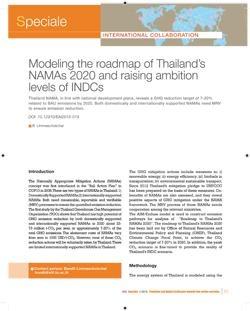
Modeling the roadmap of Thailand’s NAMAs 2020 and raising ambition levels of INDCs
B. Limmeechokchai
DOI: 10.12910/EAI2015-019
The NAMA concept, first introduced in the “Bali Action Plan” in COP13 in 2008, refers to any action that reduces emissions in developing countries. NAMA activities are not limited if they are in line with: national development plans aimed at achieving a reduction in emissions related to 'business as usual' emissions in 2020, results in the mitigation, and has an impact that can be measured, reported and verified (MRV). There are two types of NAMAs in Thailand: 1) Domestically Supported, and 2) internationally supported. Both need MRV processes to ensure the quantified emission reduction. Thailand has finished a national strategy “Roadmap to Thailand NAMAs 2020” with a clear GHG reduction target of 7-20%. In addition, Thailand now is moving towards a post-2020 agreement. The intended nationally determined contribution (INDC) of Thailand will be communicated to UNFCCC by 2015.

